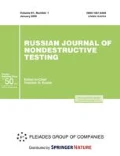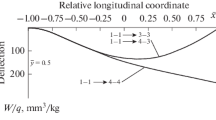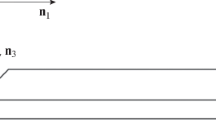Abstract
The relevance of this work is due to the need to create methods for determining the stress-strain state of acoustically anisotropic structural materials as part of technical objects operated in Arctic conditions. The specific features of using the phenomenon of acoustoelasticity for materials with different values of acoustoelastic coefficients, acoustic anisotropy, and coefficients of temperature dependence of acoustic parameters that appear in the design algorithms are analyzed. It has been established that the existing approaches to the consideration of the temperature effects in a number of crucial cases lead to noticeable errors in determining the mechanical stresses in the material of critical technical objects. In this case, consideration of the temperature corrections is necessary for both biaxial (plane) and uniaxial stress states. The presence of anisotropy in the thermoacoustic coefficients of transverse waves for materials with anisotropy has been shown experimentally. The adjusted design formulas for determining the uniaxial and biaxial stress state of an anisotropic material with the anisotropy of the thermoacoustic coefficients of shear waves taken into account are proposed.





Similar content being viewed by others
REFERENCES
Guz’, A.N., Makhort, F.G., and Gushcha, O.I., Vvedenie v akustouprugost’ (Introduction to Acoustoelasticity), Kiev: Naukova Dumka, 1977.
Bobrenko, V.M., Vangeli, M.S., and Kutsenko, A.N., Akusticheskaya tenzometriya (Acoustic Tensometry), Chisinau: Shtiintsa, 1991.
Nikitina, N.E., Akustouprugost’. Opyt prakticheskogo primeneniya (Acoustoelasticity. Practical Application Experience), Nizhny Novgorod: TALAM, 2005.
Klyuev, V. V., Nerazrushayushchii kontrol’ i diagnostika. Spravochnik (Nondestructive Testing and Diagnostics. A Handbook), Klyuev V.V., Ed., Moscow: Mashinostroenie, 2005, 3rd ed.
Trofimov, A.I., Minin, S.I., and Trofimov, M.A., Measurement of the stress state of welded joints of technological equipment and circulation pipelines of nuclear power plants based on the theory of acoustoelasticity, Izv. Vyssh. Uchebn. Zaved. Yad. Energ., 2016, no. 2, pp. 26–34.
Minin, S.I., Determination of third-order elasticity moduli for measuring stress-strain state of metal in NPP structural elements, Yad. Energ., 2018, no. 1, pp. 15–22.
Khlybov, A. A., and Ryabov, D. A., Assessment of residual stresses in specimens of ferritic-pearlitic steel with austenitic cladding, Met. Sci. Heat. Treat., 2019, no. 2 (764), pp. 45–50.
Alekseeva, E.L., Alkhiminko, A.A., Belyaev, A.K., Lobachev, A.M., Polyanskiy, V.A., Rostovykh, G.N., Tretyakov, D.A., Shtukin, L.V., and Yakovlev, Yu.A., Evaluation of stress-strain state and cracking of weatherproof structural steel by acoustoelasticity, Constr. Unique Build. Struct., 2016, no. 12(51), pp. 33–44.
Murav'ev, V.V., Volkova, L.V., Platunov, A.V., Buldakova, I.V., and Gushchina, L.V., Studies of the structural and stress-strain state of current production rails by the method of acoustoelasticity, Vestn. Izhevsk. Gos. Tekh. Univ. im. M.T. Kalashnikova, 2018, vol. 21, no. 2, pp. 11–23.
Stepanova, L.N., Beher, S.A., Kurbatov, A.N., and Tenitilov, E.S., Investigating the stressed state of a rail using acoustoelasticity and strain gaging, Izv. VUZov, Stroit., 2013, no. 7, pp. 103–109.
Murav’ov, V.V., Volkova, L.V., Platunov, A.V., and Buldakova, I.V., Estimation of the stress-strain state of rails by the methods of finite elements and acoustoelasticity, Deform. Fract. Mater., 2017, no. 1, pp. 41–44.
Murav’ev, V.V. and Volkova, L.V., Experimental estimation of residual stresses and tension of tires of locomotive wheels by the method of acoustoelasticity, Probl. Mashinostr. Nadezhnosti Mash., 2016, no. 4, pp. 98–104.
Nikitina, N.Y., Kazachek, S.V., and Kamyshev, A.V., Application of the acoustoelasticity phenomenon in studying stress states in technological pipelines, Russ. J. Nondestr. Test., 2009, vol. 45, no. 12, pp. 861–866.
Volkova, L.V., Murav’eva, O.V., Murav’ev, V.V., and Buldakova, I.V., An instrument and methods for measuring acoustic anisotropy and residual stresses in the metal of main gas pipelines, Prib. Metody Izmer., 2019, vol. 10, no. 1, pp. 42–52.
Uglov, A.L. and Khlybov, A.A., On the inspection of the stressed state of anisotropic steel pipelines using the acoustoelasticity method, Russ. J. Nondestr. Test., 2015, vol. 51, no. 4, pp. 210–216.
Buldakova, I.V., Volkova, L.V., and Murav’ev, V.V., Distribution of stresses in samples of pipes of main gas pipelines with welded joints, Intellektual’nye Sist. Proizvod., 2020, vol. 18, no. 1, pp. 4–8. http://doi.org//10.22213/2410-9304-2020-1-4-8
Nikitina, N.Y., Kamyshev, A.V., and Kazachek, S.V., The application of the acoustoelasticity method for the determination of stresses in anisotropic pipe steels, Russ. J. Nondestr. Test., 2015, vol. 51, no. 3, pp. 171–178.
Makhutov, N.A., Pasmanik, L.A., and Kamyshev, A.V., Acoustoelasticity method for assessing the stress-strain state and safety of pipeline system elements, Probl. Bezop. Chrezvychainykh Situatsii, 2018, no. 1, pp. 19–29.
Uglov, A.L., Khlybov, A.A., Bychkov, A.L., and Kuvshinov, M.O., On nondestructive testing of residual stresses in axially symmetric parts made of steel 03N17K10V10MT, Vestn. Izhevsk. Gos. Tekh. Univ. im. M.T. Kalashnikova, 2019, vol. 22, no. 4, pp. 3–9.
Murav'ev, V.V., Strizhak, V.A., and Pryakhin, A.V., Investigation of internal stresses in metal structures by the acoustoelasticity method, Zavod. Lab., Diagn. Mater., 2016, vol. 82, no. 12, pp. 52–57.
Zhan, Y., Changsheng, L., Xiangwei, K., and Zhongya, L., Experiment and numerical simulation for laser ultrasonic measurement of residual stress, Ultrasonics, 2017, vol. 73, pp. 271–276.
Abbasi, Z. and Ozevin, D., The influence of ultrasonic frequency on shear stress measurement using acoustoelasticity, Conf.: 42nd Annu.Rev. Progr. Quant. Nondestr. Eval.: Incorp. the 6th Eur.-Am. Workshop Reliab. NDE, 2016, pp. 7–10.
Albakri, M.I. and Tarazaga, P.A., A novel acoustoelastic-based technique for stress measurement in structural components, Conf. Proc. Soc. Exp. Mech. Ser. 34th. Ser. “Dynamics of Civil Structures — Proceedings of the 34th IMAC, a Conference and Exposition on Structural Dynamics, 2016,” 2016, pp. 49–56.
Grishchenko, A.I., Semenov, A.S., Tretyakov, D.A., and Shtukin, L.V., Relationship between the acoustic anisotropy parameter and measures of the stress-strain state for a specimen with a stress concentrator, in Days on Diffraction (DD), IEEE, 2017, pp. 154–158.
Belyaev, A.K., Polyanskiy, V.A., Semenov, A.S., Tretyakov, D.A., and Yakovlev, Y.A., Investigation of the correlation between acoustic anisotropy, damage and measures of the stress-strain state, Procedia Struct. Integr., 2017, vol. 6, pp. 201–207.
Nikitina, N.E. and Kazachek, S.V., Dependence of the coefficients of acoustoelasticity on the anisotropy of the physical and mechanical properties of pipe steels, Zavod. Lab., Diagn. Mater., 2013, vol. 79, no. 4, pp. 49–54.
Kamyshev, A.V., Makarov, S.V., Pasmanik, L.A., Smirnov, V.A., Modestov, V.S., and Pivkov, A.V., Generalized coefficients for measuring mechanical stresses in carbon and low-alloyed steels by the acoustoelasticity method, Russ. J. Nondestr. Test., 2017, vol. 53, no. 1, pp. 3–8.
Nikitina, N.E., Kamyshev, A.V., and Kazachek, S.V., Ultrasonic testing of the stressed state of pipelines with consideration of the temperature factor, Russ. J. Nondestr. Test., 2012, vol. 48, no. 5, pp. 272–276.
Funding
The study was carried out under the grant of the Russian Science Foundation No. 19-19-00332 “Development of scientifically grounded approaches and hardware and software tools for monitoring damage to structural materials based on artificial intelligence approaches to ensure the safe operation of technical facilities in Arctic conditions.”
Author information
Authors and Affiliations
Corresponding author
Rights and permissions
About this article
Cite this article
Khlybov, A.A., Uglov, A.L. & Ryabov, D.A. On the Specific Features of Using the Phenomenon of Acoustoelasticity When Testing the Stress State of Anisotropic Material of Technical Objects at Subzero Temperatures. Russ J Nondestruct Test 57, 21–30 (2021). https://doi.org/10.1134/S1061830921010083
Received:
Revised:
Accepted:
Published:
Issue Date:
DOI: https://doi.org/10.1134/S1061830921010083




